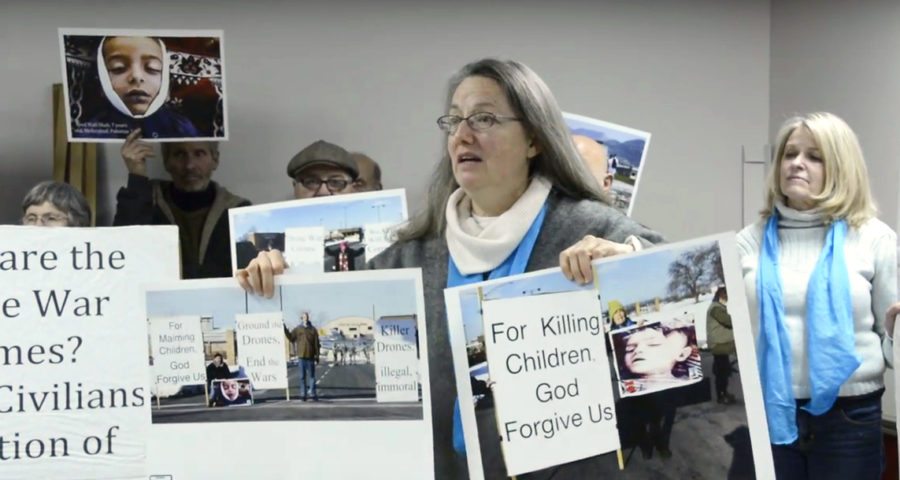
Grandma Drone Protester Appeal Hearing Scheduled
Press Release
Ithaca, N.Y. The long-awaited appeals case of Mary Anne Grady Flores, one of many Grandma drone protesters at Hancock MQ-9 Reaper Drone Base, will be heard by the panel of judges of the N.Y.S. Court of Appeals in Albany, on Oct. 11, 2017. Depending on the verdict, Grady Flores, who has already served 56 days, may have to complete 65 days in Jamesville, Onondaga County Jail, E. Syracuse.
On Feb. 13th, 2013, Ash Wednesday, Ithaca Catholic Worker Grady Flores took pictures of eight Catholic protesters from the roadway, unknowingly crossing what Hancock claims to be its boundary, “the double yellow line in the middle of the road.” Where she stood in the roadway violated a domestic violence, stay away “order of protection” (OOP’s) given by local DeWitt Court on behalf of Colonel Earl A. Evans of the 174th Attack Wing of the NY National Guard Base. In another drone protester appeal the OOP had been ruled invalid by Onondaga County Judge Brunetti because the OOP didn’t delineate how close or far people had to be from the base. Grady Flores’ OOP’s was from a previous nonviolent witness at the base, Oct. 25, 2012.
Colonel Evans testified during her 2014 trial that he didn’t know Grady Flores or ever speak with her. He said he, “That’s just a piece of paper. I just want the protesters away from my base.” Judge David S. Gideon sentenced Grady Flores to a year in jail, unsuccessfully trying to stop 50 others, many who returned to protest despite having OOP’s.
Grady Flores’ appeal contends that you cannot take an order of protection out on behalf of property. Her appeal, written by Ithaca attorney Lance Salisbury, also argues that the order threatens her First Amendment protected right of free speech. NYC attorney Jonathan Wallace of the National Lawyers Guild has submitted an amicus brief in support of her case.
The eight Catholics photographed were protesting Hancock Killer Drones, atoning for the killing and maiming of child drone victims on that February Ash Wednesday. They were acquitted of their only charge, disorderly conduct, explaining their intent was to uphold law and sound the alarm of laws being violated by the base, such as extrajudicial killing, violation of drone victims’ right to due process, violation of sovereignty laws. They contended they were there to enforce law, not there to break law.
Hancock is the largest training and maintenance center for the US MQ-9 Reaper drone program. Extra judicial killings are executed by Air Force crews sitting in front of computer screens in the Syracuse base, killing civilians in Afghanistan and Pakistan. In a five-month period in 2015, up to 90% of drone assassination victims were civilians. The base shares facilities with civilian Syracuse International Airport. Hancock Air National Guard Base has been the site of protests of the US killer drone program since 2010, resulting in about 200 arrests and numerous trials, appeals, numerous incarcerations some ending in acquittal.
###
Some Background Information:
Hancock Protester Mary Anne Grady Flores’ appeal will be heard in NYS Court of Appeals. She was convicted of violating an order of protection by standing in the street in front of the base taking photographs. The Ithaca office of Parole had submitted a pre-sentencing report that suggested Mary Anne should not be given jail time a she was not a threat to the commander or anyone else and jail time would severely impact her family and her job, but an irate judge Gideon sentenced her to a year in jail.
The OOP was requested by the Commander of Hancock Base at the time to keep known protesters from protesting at the base. Mary Anne was not protesting that day. She was doing press. The people arrested for protesting that day were acquitted of their disorderly conduct charges by Judge Jokl who found there was no intent to cause harm. In any case, should the base commander be able to use an ‘order of protection’ to secure the perimeter of the base property from unwanted information sharing? Does this really constitute a personal threat to him, and if not, how is the order of protection legal? These are among the issues that need to be addressed by the court.


